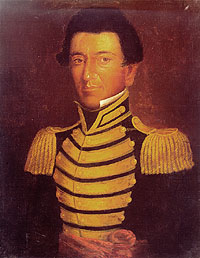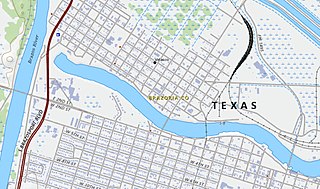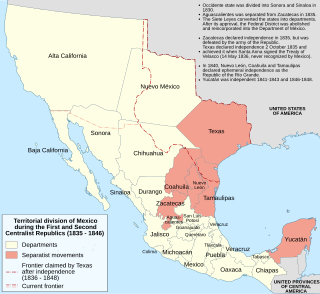Related Research Articles

Fulshear is a city in northwestern Fort Bend County, Texas, United States, and is located on the western edge of the Houston–The Woodlands–Sugar Land metropolitan area. The population was 16,856 as of the 2020 census.

Washington-on-the-Brazos is an unincorporated community along the Brazos River in Washington County, Texas, United States. The town is best known for being the site of the Convention of 1836 and the signing of the Texas Declaration of Independence.

Erastus "Deaf" Smith, who earned his nickname due to hearing loss in childhood, was an American frontiersman noted for his part in the Texas Revolution and the Army of the Republic of Texas. He fought in the Grass Fight and the Battle of San Jacinto. After the war, Deaf Smith led a company of Texas Rangers.

Juan Nepomuceno Seguín was a Spanish-Tejano political and military figure of the Texas Revolution who helped to establish the independence of Texas. Numerous places and institutions are named in his honor, including the county seat of Seguin in Guadalupe County, the Juan N. Seguin Memorial Interchange in Houston, Juan Seguin Monument in Seguin, World War II Liberty Ship SS Juan N. Seguin, Seguin High School in Arlington.
William Joel Bryan was a Texas soldier and planter.

Velasco was a town in Texas, United States, that was later merged with the city of Freeport by an election conducted by eligible voters of both municipalities on February 9, 1957. The consolidation effort passed by a margin of 17 votes. Founded in 1831, Velasco is situated on the east side of the Brazos River in southeastern Texas. It is 16 miles (26 km) south of Angleton, and 4 miles (6.4 km) from the Gulf of Mexico.
Joaquín Ramírez y Sesma was a 19th-century general for the Republic of Mexico.

The Runaway Scrape events took place mainly between September 1835 and April 1836 and were the evacuations by Texas residents fleeing the Mexican Army of Operations during the Texas Revolution, from the Battle of the Alamo through the decisive Battle of San Jacinto. The ad interim government of the new Republic of Texas and much of the civilian population fled eastward ahead of the Mexican forces. The conflict arose after Antonio López de Santa Anna abrogated the 1824 Constitution of Mexico and established martial law in Coahuila y Tejas. The Texians resisted and declared their independence. It was Sam Houston's responsibility, as the appointed commander-in-chief of the Provisional Army of Texas, to recruit and train a military force to defend the population against troops led by Santa Anna.

William Harris Wharton was an American colonist, diplomat, senator and statesman in early Texas.

Richard Andrews (1800-1835) was a Texian merchant and soldier who was the first killed in action casualty of the Texas Revolution during the Battle of Concepción on October 28, 1835. He is a folk hero for his purported final words "I am a dead man, but don't let the other boys know it. Tell them to conquer or die."

Vicente Filísola was an Italian-born Spanish and Mexican military and political figure during the 19th century. He is most well known for his role in leading the short-lived Mexican annexation of Central America between 1822 and 1823.

The Grand Lodge of Texas, Ancient Free and Accepted Masons is the largest of several governing bodies of Freemasonry in the State of Texas, being solely of the Ancients' tradition and descending from the Ancient Grand Lodge of England, founded on 17 June 1751 at the Turk's Head Tavern, Greek Street, Soho, London. According to historian James D. Carter, the "Grand Lodge of the Republic of Texas, A.F. & A.M." was founded on 16 April 1838. However, its first Grand Master and other grand officers were installed by Sam Houston on 11 May 1838. The Grand Lodge of Texas is one of the largest in the world, reporting 69,099 members in 2019. The current Grand Lodge of Texas facilities were made possible by the fundraising efforts of Waco Masonic Lodge No. 92.
The Texan schooner Independence was one of the four schooners of the First Texas Navy (1836–1838). At the direction of Texas Governor Henry Smith, in 1836 Charles Hawkins took command of United States revenue cutter Ingham acquired by the Texas Navy and renamed Independence.
Elizabeth Powell was a Texas colonist and boarding house operator.

Egypt is an unincorporated community in northern Wharton County in the U.S. state of Texas. According to the Handbook of Texas, the community had a population of 26 in 2000. It is located within the Greater Houston metropolitan area.
Sion Record Bostick was a soldier for the Texas Army during the Texas Revolution, and later fought for the Confederate States Army during the American Civil War. Bostick is most famous as one of the Texas Army scouts who captured Antonio López de Santa Anna during the Texas Revolution.

John Austin Wharton was distinguished Texian statesman, lawyer, and soldier. He served as Adjutant General at the Battle of San Jacinto. In a eulogy at his grave, Republic of Texas President David G. Burnet said of him, "The keenest blade on the field of San Jacinto is broken." He died a bachelor on December 17, 1838, while serving as a member of the Texas Congress. His nephew, John A. Wharton, who would go on to be a Confederate Army general, was named for him.
William "Bill" Smeathers, also known as Smithers or Smothers, was a pioneer settler of Kentucky and later Texas.

The Lake Creek Settlement was a settlement in Stephen F. Austin's Second Colony, located in Mexican Texas, and later the Republic of Texas after it gained independence in 1836. The Lake Creek Settlement was located between the West Fork of the San Jacinto River (Texas) and the stream known as Lake Creek. It was the first Anglo-American settlement in what is today western Montgomery County, Texas.
References
- ↑ "Statement of Robert Moore, July 24, 1836". Texas state library and archives commission.
